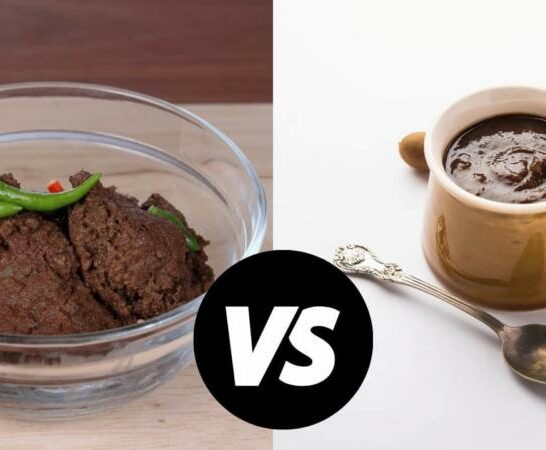A fruit from a tree of the same name, you use tamarind in Indian and Asian recipes.
Its sweetly tart flavor accompanies the flavors of these cuisines and others.
You may have had tamarind without realizing it, as it is used to flavor Worcestershire sauce and is found in pad Thai and curries.
Tamarind is preserved by making it into a paste or a puree.
Using the two items can take a little practice to adjust the amount you need for recipes.
The paste has a more intense flavor than puree because it is a dryer product and not a diluted liquid.
However, you can use either product in a recipe calling for tamarind. Then, you merely adjust the amount you use for taste.
Please continue reading to learn how to use tamarind paste vs puree and interchangeable in a recipe.
Tamarind paste vs puree
The most apparent difference between tamarind paste vs puree is that tamarind paste is very intense in flavor. When using it in a recipe, start with a small amount and add a little at a time until you get the flavor you desire. When using tamarind puree, you may need to add more than called for until you get the desired flavor. The flavor of tamarind puree is less intense than paste. However, use both products sparingly because you cannot remove them once you add them to the dish.
How is tamarind paste made?
You can buy tamarind paste or easily make it yourself. It will be free of the preservatives added to most processed products.
To make tamarind paste, use 10 to 12 fresh tamarind pods, remove their skin and the strings, then cut the pulp into a few pieces.
The pulp is then rinsed and added to a bowl filled with two cups of hot water.
After softening the pulp, put it and the water into a strainer and mash it through the mesh with a spoon to squeeze the pulp and seeds out.
Using this process, strain it two more times, put the pulp into a saucepan, bring it to a boil, and cook it for five minutes.
When done, please remove it from the heat, cool it, and put it into a glass jar. It will keep in the refrigerator for about a month, or the freezer for about six months.
How is tamarind puree made?
It is made by pouring hot water over tamarind pulp, sold as wet tamarind pulp.
Let it stand for about an hour, then break it into small pieces while in the water.
After breaking it into small pieces, let it soak for about three hours. At the end of this time, mash the pulp through a strainer, keep the liquid, and discard in the fiber and seeds.
Put the puree you have made in a jar, seal it well and refrigerate it after it has cooled. Due to its acidity, it will keep in the refrigerator for several months.
If you do not want to take the time to make tamarind puree, you can buy it in most good grocery stores. However, making it fresh means it is free of preservatives.
Can fresh tamarind be used in recipes?
A little of this fresh fruit can have a milder, rounder flavor than paste or puree.
Using fresh tamarind pods will add prep time to your recipe. However, be sure to allow a few extra minutes for your recipe when using fresh tamarind.
Although using a fresh product is always best, it is not always the most convenient way to get tamarind flavors into your recipes.
However, fresh tamarind pods are not always available. Having paste or puree on hand will ensure you always have the ingredients necessary to make your favorite recipes.
Whether you make your tamarind paste and puree from scratch or buy it processed, you need it in your fridge.
It is challenging to create authentic Asian and Indian dishes without tamarind as an ingredient.
What recipes can you make with tamarind?
You may have eaten dishes at your local Asian restaurant that had tamarind as an ingredient if you have eaten beef and broccoli, vegetable curry, Tamarind balls, Pad Thai, or Agua Fresca.
This fruit’s tart and sweet flavor impart these qualities into sweet and sour dishes.
It is an ingredient in Pad Thai sauce, Worcestershire sauce, curry sauces, and many marinades, chutneys, and barbeque sauces.
Whether used in the main recipe or a sauce, the unique flavor of tamarind is an ingredient you need for many recipes you have had and those you have yet to create.
Frequently Asked Questions About Tamarind Paste vs Puree
Is tamarind paste and puree interchangeable?
Tamarind paste and puree are interchangeable. But tamarind paste is more concentrated than puree.
Is there a difference between cooking with tamarind paste vs puree?
Tamarind paste is more concentrated than puree, so you need more to get the same flavor.
Does Tamarind have health benefits?
Tamarind is rich in magnesium, an essential element that offers an added benefit to your recipes.
Using tamarind paste vs puree in your recipes
Whether you use tamarind or paste and puree, this ingredient is necessary for many Asian and Indian recipes.
It is hard to get the right flavors for these dishes without the right ingredients.
The sweet and tart flavor imparted to your dishes by tamarind gives them authentic flavors.
Although other ingredients will mimic tamarinds flavors, such as lime juice and brown sugar, nothing else tastes quite like tamarind.

